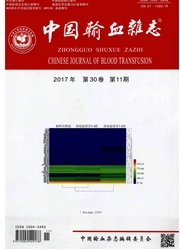

 中文摘要:
中文摘要:
目的 探讨不同氧化模型制备时红细胞聚集性和变形性的变化。方法 从15只大鼠颈动脉采集血液9m L/只,离心去除白细胞,获得红细胞重悬液分为4组(n=3):空白对照组(不加入任何氧化剂);过氧化氢(H2O2)组(终浓度为0.5、5、8 mmol/L);吩嗪硫酸甲酯(PMS)组(终浓度为25、50、100μmol/L),亚硝酸钠(Na NO2)组(终浓度为0.5、1、1.5 mmol/L);37℃水浴1 h,自体血浆调节红细胞压积至40%,测定红细胞聚集性和变形性。结果 红细胞聚集指数:H2O2组呈下降趋势,终浓度8 mmol/L时的2.5±1.3,较对照组的45.3±1.5下降明显(P〈0.05);PMS和Na NO2组则较对照组均无明显变化(P〉0.05)。红细胞聚集时间(s):与对照组的0.89±0.13相比,H2O2组作用浓度为5、8 mmol/L时明显升高,分别为1.68±0.2、1.85±0.14(P〈0.05);PMS组各作用浓度未见明显影响(P〉0.05);Na NO2组各终浓度作用后,虽然分别降低至0.54±0.06、0.62±0.03和0.78±0.08,但也显示作用浓度越高降低越慢。红细胞变形性:各个剪切速率(SHR)下,对照组EI分别为28.1±0.45、40.6±0.92、42.4±1.09、43.2±1.12、44±1.21。3种浓度H2O2作用后,不同SHR下EI均明显下降(SHR=100 s^-1时EI分别为18.8±3.78、11.3±2.36、6.9±4.89,P〈0.05);3种浓度PMS作用后,不同SHR下EI均明显下降(SHR=100 s^-1时EI分别为16.8±2.27、8.5±0.64、5.6±0.07,P〈0.05);3种浓度Na NO2作用后,SHR=100 s^-1时,变形性降低(分别为23.9±1.41、20.8±0.01、21.9±041,P〈0.05),但随着SHR的增大,变形性有升高趋势,SHR≥600 s^-1时,Na NO2组红细胞变形性明显高于对照组(SHR=1000 s^-1时EI分别为48.3±0.73、49.2±0.1、48.3±0.65,P〈0.05)。结论 不同氧化剂对红细胞聚集性和变形性影响不同,提示在体外建立红细胞氧化损伤模型时应根据实验目的选取符合要求的氧化剂。
 英文摘要:
英文摘要:
Objective To investigate the changes of erythrocyte aggregation and deformability during establishing different oxidative models. Methods:Whole blood was obtained from the carotid artery of 15 rats,at 9mL each. The samples were centrifuged and the buffy coat was removed. Red blood cells (RBC) suspensions were divided into four groups ( n = 3 ) : Group control; Group H2O2 (hydrogen peroxide) which final concentration were 0.5, 5 and 8 mmol/L respectively; Group phenazine methosulfate(PMS) which final concentration were 25, 50 and 100 μmol/L respectively; Group NaNO2 (sodium nitrite) which final concentration were 0.5, 1 and 1.5 mmol/L respectively. All groups were then incubated for lh at 37qE. The samples were centrifuged and the hematocrit of all samples was then adjusted to 40% with self-plasma before the measurements on erythrocyte aggregation and deformability. Results Aggregation index (AI) : AI in Group H2O2 decreased and was significantly lower at 8 mmol/L which was 32. 5 ± 1.3 compared with Group contrd which was 45.3 ±1.5 ( P 〈 0. 05) ; AI in Group PMS and NaNO2 were not significantly different (P 〉0. 05). Top time (TT) : TT increased when H2Ozwas at 5 mmol/L and 8 mmol/L, which werel. 68 ±0.2 s and 1.85 ±0. 14 s, respectively and show significantly different compared with Group control (0. 89 ±0. 13 s) (P 〈0. 05) ; PMS showed no effect on TT (P 〉0. 05) ; TT decreased in Group NaNO2 which were 0. 54 ±0.06 s, 0.62 ±0.03 s and 0.78 ±0.08 s, respectively compared with control, while it increased as the concentration increased but still lower than Group control. Elongation index (EI) : EI at all shear rate (SHR) in Group control were 28. 1 ±0. 45,40. 6 ±0. 92,42.4±1.09,43.2 ±1.12, 44 ±1.21. EI decreased significantly at all SHR in Group H202 (SHR=100 s^-1, Ei were 18.8 ±3.78,11.3 ±2.36,6.9 ±4. 89,P 〈0. 05) ; EI decreased significantly at all SHR in Group PMS (SHR = 100 s^-1, El were 16. 8 ±2. 27,8. 5 ±0. 64,5
 同期刊论文项目
同期刊论文项目
 同项目期刊论文
同项目期刊论文
 期刊信息
期刊信息
